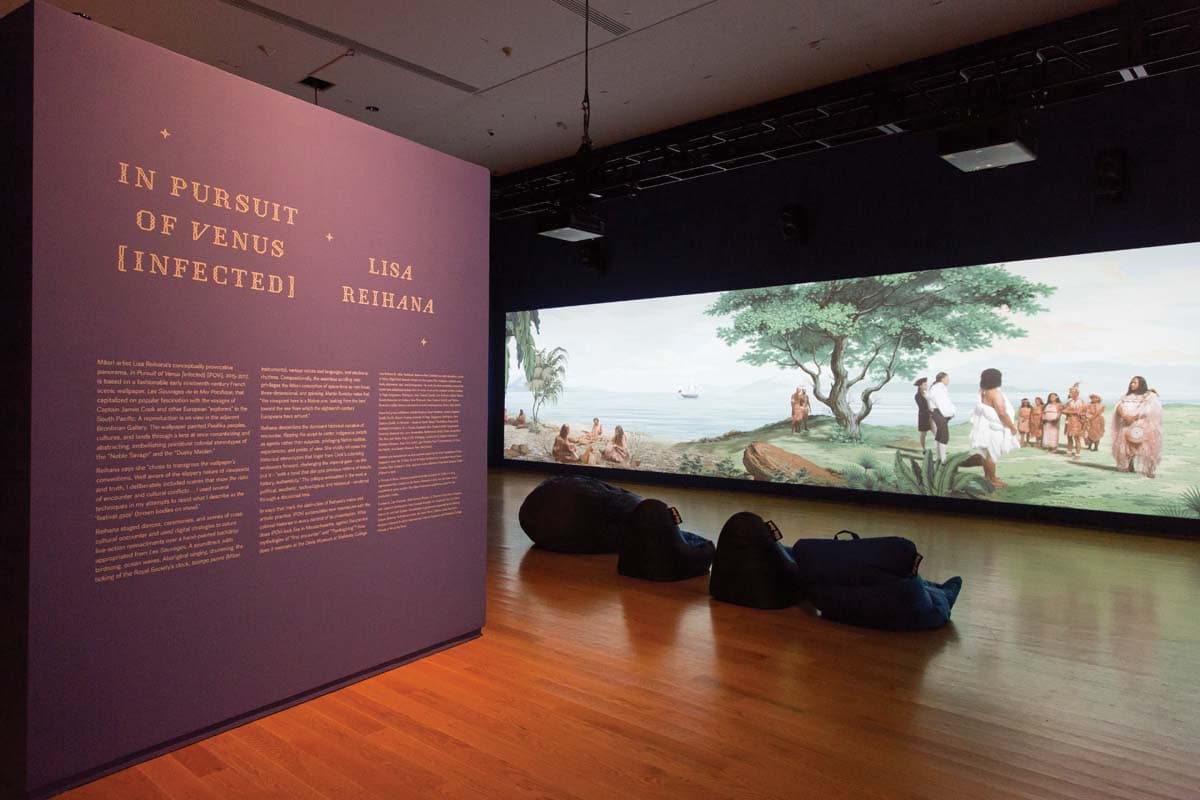Lisa Reihana is a Maori artist who explores history, identity, and cultural representation, often through photography and film. Her engrossing panoramic film in Pursuit of Venus [infected] (iPOVi), 2015–2017, riffs on French painter Jean-Gabriel Charvet’s 1805 wallpaper design Les Sauvages de la Mer Pacifique, which presented a fabulated depiction of reports from colonial voyages in the late 1700s. Reihana’s digital version includes simplified backdrops reminiscent of Charvet. She envisions similar coastal coconut trees, mountains, and grassy shores. Yet Reihana replaces Charvet’s strangely decorative and Neoclassical figurative misrepresentations of Indigenous peoples with dozens of actors and dancers sensitive to the risk, intimacy, and potential brutality of cross-cultural encounters. Using green-screen technology, Reihana and her cast create plausible vignettes referencing early contact in the Pacific between Europeans and Pacific peoples. The immersive, hour-long, multi-projector video seamlessly scrolls left and loops, playing uninterrupted on an enormous wall, about eighty feet long, the entire length of a massive gallery.
in Pursuit of Venus [infected] has been shown in various forms in San Francisco, Israel, Australia, Estonia, France, Canada, England, Hawaii, and South Africa. It was featured when Reihana represented New Zealand at the Venice Biennale. New Englanders had a chance to view the mural-sized video at Brown University’s Bell Gallery for the first half of this year. They get a second chance through December at Wellesley College’s Davis Museum.
At Wellesley, the video felt sometimes modest, warm, or quiet and stylistically only a notch or two above realistic in theatricality. Despite its impressive scale, historical significance, and sometimes ominous implications, it is somewhat understated. Reihana’s camera keeps a respectful distance. Separate vignettes appear at the far right side of the gallery and move left. They’re like unvarnished human tableaus activated briefly. We see and hear small groups of Indigenous people conducting private ceremonies, performing traditional dances, or sharing cultural practices like tattooing. Seagulls call to each other while waves lap against the shore. Western sailors sing softly about islands, their captain, and fresh fruit. We witness instances of cultural confusion, like when two Hawaiians amuse themselves by trying on Western clothes, putting legs into armholes, and strutting in mocking imitation of their ultimately infectious new visitors. In other scenes, tensions flare into standoffs or weapons come out.
Catalogs of Reihana’s work describe the historical characters appearing in the video. There are warriors, brides, European astronomers, a Tahitian chief mourner, and British captain James Cook, who circled the world collecting objects and status. Perhaps to suggest the gender fluidity in some Polynesian cultures or the unclassifiable and larger-than-life aspects of Cook’s persona, Reihana cast Cook as both male and female. He’s played alternately by two different actors. His death and the events surrounding it are featured prominently. Before seeing the film, you might wonder why Reihana focuses so much on Cook, who she herself describes as “arguably the harbinger of colonization in the South Pacific.” In a 2015 interview, Reihana suggests that audiences trying to decipher the events of Cook’s life and death will gain insight into how Hawaiians and Europeans interpreted the same actions differently. She describes a difficult vignette following Cook’s death this way: “Cook’s tricorne hat and a thigh from his dismembered body are returned to [his] crew, who are offended and sickened. Pacific people may understand this differently: the thigh is a prestigious body part, and Cook’s hat is sacred due to its relationship to his head.”
I turned to Anne Salmond’s 2003 book, The Trial of the Cannibal Dog: Captain Cook in the South Seas, to understand more about the circumstances of Cook’s death. By February 1779, Cook and his crew had outworn their welcome in Kealakekua Bay, Hawaii, in part because they hung on to Western notions of property ownership and hierarchy, fundamentally misreading Hawaiian motivations or trouncing their customs. According to Salmond, the Hawaiians were wary of Cook permanently settling in the bay. Following a string of mounting hostilities, Cook shot a warrior and a chief at close range, then warriors clubbed and stabbed him to death.
Watching Reihana’s reenactments of these events and then walking upstairs through the galleries at the Davis Museum, I felt strange stumbling upon an unrelated display of Oceanic art. I considered an Asmat warrior’s shield and then a nearby dagger made from bone, feathers, shells, hair, clay, and paint (both from New Guinea). I wondered how Reihana’s work, or the lessons we learn from it, could further inform, or perhaps even reform, the rest of the museum. Are these artifacts of encounter now objects the museum could discuss returning? I think it could be helpful to explore a gesture like this even if it wouldn’t fully address colonialism’s enduring impacts—its insidious scroll so thoroughly evoked through Reihana’s work.
“Lisa Reihana: in Pursuit of Venus [infected]” is on view at the Davis Museum at Wellesley College from September 15 to December 18, 2022.


